
This page is part of © FOTW Flags Of The World website
Dictionary of Vexillology: L (Labarum - Layered Saltire)
Last modified: 2016-05-23 by rob raeside
Keywords: vexillological terms |
Links: FOTW homepage |
search |
disclaimer and copyright |
write us |
mirrors
On this page:
- LABARUM
- LABEL
- LAMB OF GOD
- LANCE
- LANCE FLAG (or PENNANT)
- LANCE PENNON
- LANCEOLATE
- LANDESFARBEN
- LANGUAGE FLAGS
- LANGUED
- LANYARD
- LANYARD PENNANT
- LAPEL FLAG (or PIN)
- LAPPED
- LARMES
- LATE-GOTHIC (or LATE-GOTHIC-STYLE) SHIELD LATE-GOTHIC (or LATE-GOTHIC-STYLE) SHIELD
- LATIN CROSS
- LATIN CROSS THROUGHOUT
- LATTICE
- LAUNCHING FLAGS
- LAY UP COLORS
- LAYERED CROSS
- LAYERED SALTIRE
- LABARUM
- 1) A flag based on the vexillum and combining Christian symbols with those of the
Roman military, introduced by the Emperor Constantine in the early 4th Century AD, and
later used as an imperial standard (see also ‘vexillum’).
2) The term sometimes used to describe a (comparatively) simple religious banner – see ‘banner 3)’.Please note - not to be confused with a cantabrian labarum (see 'cantabrian labarum').
![[labarum]](../images/v/vxt-d1200a.gif)
![[labarum]](../images/v/vxt-d1200b.jpg)
The Labarum of Constantine: Modern Religious Labara (Wikipedia) - LABEL
- 1) See ‘cadency, mark of’.
- 2) In heraldry a term sometimes also used to describe the tapes which hang below a prelate’s mitre – but see ‘stringed’.
- 3) In British usage, the (varyingly detailed) marks of cadency employed on the standards of particular Royal Family members (see also ‘royal
standard(s) 2)’, plus ‘cadency, mark of’ and its following note
‘difference 1)’ and
‘variant 1)’).
![[label example]](../images/v/vxt-d2220.gif)
![[label example]](../images/v/vxt-d1686.gif)
![[label example]](../images/v/vxt-d595.gif)
British Royal Standards Showing the Labels of HRH The Prince of Wales, HRH Prince William and of HRH Princess Anne (fotw) - LAMB OF GOD
- See ‘agnus dei’.
![[lamb of God]](../images/v/vxt-d376.gif)
Flag of Berlikum, The Netherlands (fotw) - LANCE
- A long light-weight spear with which some cavalry regiments were formerly armed, and upon which the standard or guidon was also carried - now restricted to historical or ceremonial use (see also ‘guidon 1) & 2)’, ‘lance flag’, ‘lance pennon 1)’, ‘staff 2)’ and ‘standard 2)’).
- LANCE FLAG (or PENNANT)
- A small flag or pennant, usually swallow-tailed or triangular and of
generally simple (bicolour) design, formerly carried below the lance head by
those cavalry regiments so armed, or currently by some mounted police units in
parade dress, and now restricted to historical/ceremonial use - a lance pennon (see
also ‘banneret 2)’,
‘pennant 2)’,
‘lance’ and ‘lance pennon 1)’).
![[lance flag]](../images/v/vxt-d193.gif)
![[lance flag]](../images/v/vxt-d595a.gif)
![[lance flag]](../images/v/vxt-d595b.gif)
From left: Lance Flags, British c1840; Mounted Police, New South Wales and Victoria, AustraliaPlease note that the use of lance-armed cavalry and the general design of their flag or pennant derive from Polish practice – Poland having been the country from which lance-armed light cavalry was adopted in the late 18th century.
- LANCE PENNON
- 1)The term for an armigerous lance flag, either triangular, either
fork-tailed or square-ended according to rank, and carried by a medieval mounted knight (see also
‘armigerous’,
‘banner of arms’,
‘banneret 2)’, ‘lance’,
‘lance flag’,
‘pennoncier’ and ‘heraldic standard’.
2) 2) See ‘badge pennon’.
3) See ‘lance flag’.![[Lance pennon]](../images/v/vxt-d1088.gif)

![[Lance pennon]](../images/v/vxt-d668.gif)
Lance Pennon of Sir Robert Knolles. Knight Banneret c1360, England; Lance Pennon of a Pennoncier (or Knight Bachelor), England 1415; Badge Pennon, England c1460 - LANCEOLATE
- (adj) A term used that may be used to describe a rounded fly – but see
‘ogival’
(also ‘descate’,
‘guidon 3)’,
’fly’,
‘standard 4)’ and ‘heraldic standard’).



Examples (2); Flag of Lesna, Poland (Jarig Bakker)Please note that the differences between “ovigal” and “lanceolate” are often very slight, and we suggest that both entries be consulted.
- LANDESFARBEN
- See 'national colours 2)' and
'state colours 3)' (also
'livery colours').




Landesfarben/National Colours, Germany; Landesfarben/State Colours, Brandenburg, Saxony and Saxony-Anhalt - LANGUAGE FLAGS
- See ‘linguistic flags’.
- LANGUED
- The heraldic term used when the tongue of the beast, if shown, is of different tincture
than the rest of the body (see also ‘armed 2)’,
‘armed and langued’,
‘attired’,
‘beaked’,
‘membered’ and
‘tincture’).
See ‘appendix V’
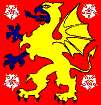

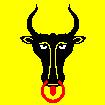
Flag of Östergötland, Sweden (fotw); Flag of Aalter, Belgium (fotw); Flag of Uri, Switzerland (fotw) -
- LANYARD
- 1) In French military usage and in some others – and a translation of fourragère
– the term for those cords and tassels that are worn on military uniforms to signify the
award of a unit decoration, and may decorate that unit's military colour – see
‘cord 1)’
and ‘aiguillette’
(also ‘colour 2)’,
‘cravat 1)’,
‘jack of honour’,
‘lanyard pennant’ and
‘tassels’).
2) See ‘halyard’.
3) See ‘dress knot’ and its following note. - LANYARD PENNANT
- In French Naval usage, the term – and a translation of flamme de
fourragère - for a tapered pennant in various colours, charged with the Croix de Guerre
and having a rounded (or lanceolate) fly, which is flown to indicate that a vessel has received
citations for a certain number of military decorations (see also ‘cravat 1) and its following
note,
‘fanion 3)’,
‘jack of honour’,
‘lanceolate’ ,
‘lanyard 1)’ and
‘pennant 2)’).
![[Lanyard pennants]](../images/v/vxt-d196.gif)
From left: 6 Citations for the Legion d’Honneur, 1914-18 (fotw); 4-5 Citations for the Médaille Militaire 1939-45 (fotw) - LAPEL FLAG (or PIN)
- 1) A metal or plastic flag – sometimes showing a badge or coat of arms below - worn on the dress or coat lapel as a patriotic or political symbol, originally characteristic of the former Soviet Union and of the United States, but now widely used elsewhere – a flag badge or flag pin.
- 2) A paper flag see ‘flag day 2)’.
- LAPPED
- A term sometimes incorrectly used to describe the leaves of a rose in place of the heraldic barbed – see ‘barbed’.
- LARMES
- See ‘gouttes’.
![[larmes]](../images/v/vxt-d378.gif)
![[gutty / larmes]](../images/v/vxt-d378a.gif)
Flag and Arms of Samnanger, Norway (fotw) - LATE-GOTHIC (or LATE-GOTHIC-STYLE) SHIELD
- The term sometimes used (albeit inaccurately) in vexillology to describe a round-bottomed or Spanish-style shield -
but see note below (also ‘rectangular shield’,
‘shield 2)’ and
‘spanish-style shield’).
Please note that in vexillology the terms Gothic and late-Gothic appear to be used indiscriminately to describe either a pointed or a round-bottomed shield, and the Editors suggest therefore, that both these terms, if used at all, should be restricted to those with a pointed base.
- LATIN CROSS
- See ‘appendix VIII’.
![[example]](../images/v/vxt-d1865.gif)
![[Latin cross]](../images/v/vxt-d1866a.gif)
![[Latin cross]](../images/v/vxt-d1866b.gif)
From Left: Latin Cross Example; Flag and Arms of Budinšćina, Croatia (Fame) - LATIN CROSS BOTTONY
- See ‘cross of victory’.
![[Latin cross bottony]](../images/v/vxt-d2634.gif)
![[Latin cross bottony]](../images/v/vxt-d2862.gif)
Flag and Arms of Asturias, Spain (fotw & ICH) - LATIN CROSS THROUGHOUT
- See ‘appendix VIII’, and
‘off-centred cross 2)’ with its
following note.
![[Latin cross throughout]](../images/v/vxt-d1867.gif)
Flag of Thunstetten, Switzerland (fotw) - LATTICE
- 1) In vexillology a pattern of interlaced bars forming a (usually but not invariably) diagonal trellis.
2) In heraldry as above but see 'fretty'.![[lattice example]](../images/v/vxt-d2785.gif)
![[lattice example]](../images/v/vxt-d2785a.gif)
![[lattice example]](../images/v/vxt-d2786.gif)
![[lattice example]](../images/v/vxt-d2786a.gif)
Flag and Arms of Glinde, Germany (fotw); Flag and Arms of Haňovice, Czech Republic (fotw) - LAUNCHING FLAGS
- Those flags flown from a vessel that is being launched prior to fitting out, and which in naval usage are generally (but not invariably) of a prescribed type and sequence (see also ‘dressing lines’ and ‘flag exchange’.
- LAY UP (or LAYING UP) COLOURS (or COLORS)
- (v) The ceremonial deposit of regimental, unit, service or national colours in a church, cathedral or museum when they are worn out, or when the regiment or military organisation is disbanded (see also ‘colour 2)’ and ‘colours 2)’.
- LAYERED CROSS
- A term that may be used to describe a cross whose horizontal arm differs in colour
from its vertical as in the flag of the former Netherlands Antilles (see also ‘cross 1)’,
‘layered saltire’,
‘trinitarian cross’
and ‘tripartite’).
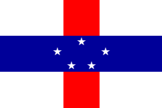
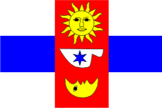
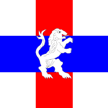
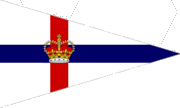
Flag of the Netherlands Antilles 1986 - 2010 (fotw); Flag of Bělov, Czech Republic (fotw); Flag of Obecuri, Spain (Ivan Sache); Burgee of the Royal Yacht Club of Tasmania (Clay Moss)Notes
a) This term has been introduced by the Editors as no established alternative could be found.
b) It should only be used in the description of flags as illustrated above, and does not include crosses which show two colours because of a fimbriation, or are divided in ways other than those shown. - LAYERED SALTIRE
- A term that may be used to describe any saltire where an arm of one colour overlays (or
apparently overlays) an arm of a different colour as in the examples given below (see also
‘layered cross’, ‘saltire’
and ‘tripartite’).
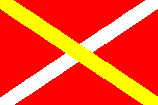
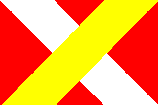
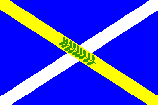

Flag of Rubi, Spain (fotw); Flag of Horní Cerekev, Czech Republic; City of Alfarràs, Spain (fotw); Flag of Miami-Dade County, Florida, USA (fotw)Notes
a) This term has been introduced by the Editors as no established alternative could be found.
b) It should only be used in the description of flags as illustrated above, and does not include saltires which show two colours because of a fimbriation, or are divided in ways other than those shown.
Introduction | Table of Contents | Index of Terms | Previous Page | Next Page
![[lancer]](../images/v/vxt-d2334.jpg)
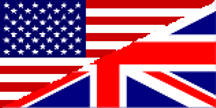

![[fourangère]](../images/v/vxt-d1419.jpg)
![[flag pin]](../images/v/vxt-d899b.jpg)
![[flag pin]](../images/v/vxt-d899a.jpg)
![[launching flags]](../images/v/vxt-d421.jpg)